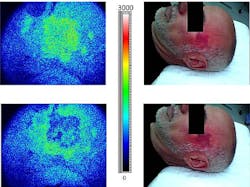LASER SPECKLE IMAGING: Real-time LSI improves port wine stain treatment
Numerous methods have been developed to improve imaging within turbid or scattering media such as human tissue. Although laser speckle imaging (LSI) has been successful for before-and-after blood-flow analysis in patients undergoing laser-based port wine stain (PWS) treatment, hardware and processing issues have limited LSI to pre- and post-treatment analysis only. But recent developments from a team of researchers at the Beckman Laser Institute and Medical Clinic at the University of California–Irvine now provide physicians with real-time feedback during PWS treatment, improving the efficacy of these laser-based procedures for the 0.3–0.5% of the population born with this birthmark annually.1
Quantifying blood flow
It is generally acknowledged that laser therapy induces purpura (hemorrhaging in the skin) and lightens PWS birthmarks through photocoagulation of the blood. Speckle flow index (SFI) maps quantify the degree of photocoagulation using LSI.
For second-generation real-time imaging, the LSI equipment setup includes a continuous-wave 30 mW 633 nm helium-neon (HeNe) laser, a thermoelectrically cooled 1600 × 1200 pixel CCD camera with 7.4 μm square pixels and 8.3 frames/s imaging speed at full resolution, and code based on LabVIEW (National Instruments; Austin, TX) that enables real-time processing of raw laser speckle images at the 8.3 frames/s video rate. Custom code was written to perform all image processing on the NVIDIA graphics processing unit (GPU). Because overhead lights in the treatment room corrupt the speckle images, a 633 nm filter was added to the CCD camera for LSI image acquisition.
Based on previous flow phantom studies, camera exposures of 10 ms were found to be ideal. The HeNe laser illumination is passed through a ground-glass diffuser and projected on the patient’s skin. Changes in spatial intensity caused by the motion of optical scatterers were analyzed using a sliding window (7 × 7 pixels) to convert raw speckle images into a speckle-contrast image. A speckle-contrast equation was defined by assuming a Lorentzian intensity correlation function in the absence of direct vascular visualization.
During PWS treatment, color-coded SFI values showed high-blood-flow regions in green and photocoagulated regions as blue (see figure). Analysis of LSI patient data during treatment at the Beckman Laser Institute at UCI was able to establish that alexandrite laser treatment of deeper vasculature showed minimal change to SFI data, while pulsed-dye laser treatment intended for superficial vasculature showed measurable reductions in SFI. The real-time data can help guide physicians to perform additional treatments in an interoperative setting rather than waiting to view pre- and post-treatment results.
“With the successful integration of real-time LSI into the general clinical workflow at Beckman Laser Institute, we are excited at the possibility of reducing the number of treatment sessions required for patients,” says Bernard Choi, associate professor of surgery and biomedical engineering at UCI and prinicipal investigator on this project. “LSI itself is quite attractive as an imaging modality because of the simplicity of the technology; all you need is a laser, camera, and computer.”
REFERENCE
1. B. Choi, “Camera-Based Functional Imaging of Tissue Hemodynamics,” SPIE Photonics West BiOS Hot Topics session (Feb. 2, 2013).

Gail Overton | Senior Editor (2004-2020)
Gail has more than 30 years of engineering, marketing, product management, and editorial experience in the photonics and optical communications industry. Before joining the staff at Laser Focus World in 2004, she held many product management and product marketing roles in the fiber-optics industry, most notably at Hughes (El Segundo, CA), GTE Labs (Waltham, MA), Corning (Corning, NY), Photon Kinetics (Beaverton, OR), and Newport Corporation (Irvine, CA). During her marketing career, Gail published articles in WDM Solutions and Sensors magazine and traveled internationally to conduct product and sales training. Gail received her BS degree in physics, with an emphasis in optics, from San Diego State University in San Diego, CA in May 1986.
